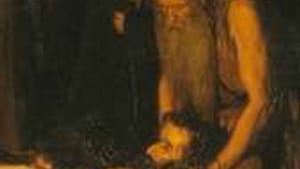Stay in the Loop
BSR publishes on a weekly schedule, with an email newsletter every Wednesday and Thursday morning. There’s no paywall, and subscribing is always free.
Extraordinary painter, extraordinary family
Henry Tanner's civil rights roots

The current Henry Tanner retrospective at the Pennsylvania Academy of Fine Arts properly celebrates this often-neglected artist. But Tanner's place in Philadelphia's early civil rights history deserves to be acknowledged as well. Like Octavius Catto, another black Philadelphian of the post-Civil War era, Tanner's career as a painter was inextricably shaped by the threads of black history, his personal relationships and his community.
Tanner was born in 1859 into a free black family that was deeply committed to ending slavery and advancing civil rights and opportunities for African Americans. Tanner's middle name, Ossawa, is drawn from the abolitionist town of Osawatomie, Kansas, which was largely destroyed in 1856 by pro-slavery forces after a battle with John Brown's free state guerrillas during the conflict over whether Kansas would enter the union slave or free. (Brown was hanged on December 2, 1859, barely four months after Henry's birth.)
Tanner's mother was born into slavery but was sent North by her mother on the Underground Railroad. His father, Benjamin Tucker Tanner, was an early black college graduate and became an important figure in black education and social justice as bishop of the African Methodist Episcopal church in Philadelphia, as well as editor of the Christian Recorder and the AME Review.
Benjamin Tanner's very close friend was the equal rights activist Octavius V. Catto; after Catto was murdered during an Election Day race riot in 1871, Benjamin Tanner delivered a eulogy that constituted an early rallying cry of the civil rights movement: "The martyr rests," he declared, "and we a million strong, backed by a million more…do swear that not a rock from out his mount shall ever be removed."
It's hard to believe that these events didn't influence Henry Tanner in extraordinary ways (not to mention influencing Henry Tanner's niece, the equally fearless and outspoken civil rights icon Sadie Tanner Alexander). I sometimes like to imagine what the conversations must have been like at his family's dinner table when young Henry was growing up in the 1860s and '70s.
Henry Tanner's lesson, both as a painter and as a citizen, is that everyone's story contains more texture and depth than what you see on the surface. It's a thought worth keeping in mind as you peruse Henry Tanner's marvelous works at the Pennsylvania Academy.♦
To read Anne R. Fabbri's review of the Tanner exhibit, click here.
To read a response by Victoria Skelly, click here.
Tanner was born in 1859 into a free black family that was deeply committed to ending slavery and advancing civil rights and opportunities for African Americans. Tanner's middle name, Ossawa, is drawn from the abolitionist town of Osawatomie, Kansas, which was largely destroyed in 1856 by pro-slavery forces after a battle with John Brown's free state guerrillas during the conflict over whether Kansas would enter the union slave or free. (Brown was hanged on December 2, 1859, barely four months after Henry's birth.)
Tanner's mother was born into slavery but was sent North by her mother on the Underground Railroad. His father, Benjamin Tucker Tanner, was an early black college graduate and became an important figure in black education and social justice as bishop of the African Methodist Episcopal church in Philadelphia, as well as editor of the Christian Recorder and the AME Review.
Benjamin Tanner's very close friend was the equal rights activist Octavius V. Catto; after Catto was murdered during an Election Day race riot in 1871, Benjamin Tanner delivered a eulogy that constituted an early rallying cry of the civil rights movement: "The martyr rests," he declared, "and we a million strong, backed by a million more…do swear that not a rock from out his mount shall ever be removed."
It's hard to believe that these events didn't influence Henry Tanner in extraordinary ways (not to mention influencing Henry Tanner's niece, the equally fearless and outspoken civil rights icon Sadie Tanner Alexander). I sometimes like to imagine what the conversations must have been like at his family's dinner table when young Henry was growing up in the 1860s and '70s.
Henry Tanner's lesson, both as a painter and as a citizen, is that everyone's story contains more texture and depth than what you see on the surface. It's a thought worth keeping in mind as you peruse Henry Tanner's marvelous works at the Pennsylvania Academy.♦
To read Anne R. Fabbri's review of the Tanner exhibit, click here.
To read a response by Victoria Skelly, click here.
What, When, Where
“Henry Ossawa Tanner: Modern Spirit.†Through April 15, 2012 at Hamilton Hall, Pennsylvania Academy of the Fine Arts, 128 N. Broad St. (at Cherry). (215) 972-7625 or www.pafa.org.
Sign up for our newsletter
All of the week's new articles, all in one place. Sign up for the free weekly BSR newsletters, and don't miss a conversation.

 V Chapman Smith
V Chapman Smith